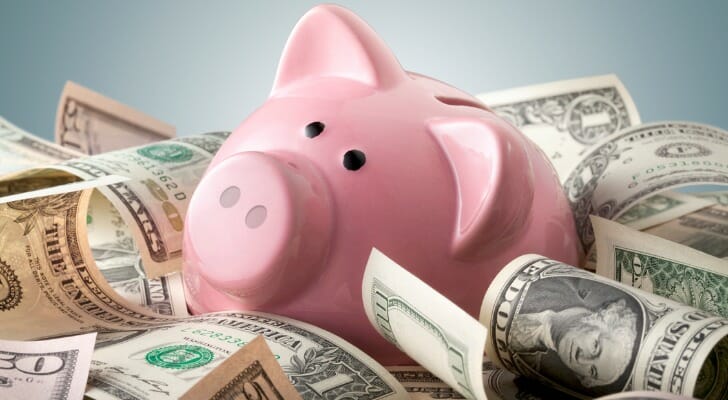The coupon rate is the fixed annual rate at which a guaranteed-income security, typically a bond, pays its holder or owner. It is based on the face value of the bond at the time of issue, otherwise known as the bond’s “par value” or principal. Though the coupon rate on bonds and other securities can pay off for investors, you have to know how to calculate and evaluate this important number.
Consider working with a financial advisor as you create or modify the fixed-income portion of your investment portfolio.
What Is a Bond?
A bond is a type of investment in which you as the investor loan money to a borrower, with the expectation that you’ll get your money back with interest after the term of the loan expires. Bonds are a type of fixed-income investment, which means you know the return that you’ll get before you purchase. Bonds can be issued, meaning put up for sale, by the federal and state governments as well as companies.
Bonds are one of two ways you can invest in a business. The other is to buy a company’s stock. While bonds represent a debt investment, the company owes you money, stock represents an equity investment, which means you own part of the company.
Bonds appeal to investors because they offer predictable income and are generally less volatile than stocks. They’re often used to balance risk within a portfolio, generate steady cash flow or preserve capital over time. Understanding what a bond is and how it functions lays the foundation for grasping concepts like coupon rate, yield and market value, key components of making informed fixed-income investment decisions.
What Is Bond Coupon Rate?
Coupon rate, also known as the nominal rate, nominal yield or coupon payment, is a percentage that describes how much is paid by a fixed-income security to the owner of that security during the duration of that bond.
For example, you can purchase a 10-year bond with a face value of $100 and a bond coupon rate of 5%. Every year, the bond will pay you 5% of its value, or $5, until it expires in a decade. That active payment occurs on a fixed basis, usually twice a year.
Historically, when investors purchased a bond they would receive a sheet of paper coupons. The investor would return these coupons on a regular basis and receive their payment in exchange. Today most issuers make payments electronically.
How Bond Coupon Rate Is Calculated

The coupon rate is calculated by adding up the total amount of annual payments made by a bond, then dividing that by the face value (or “par value”) of the bond. For example: ABC Corp. releases a bond worth $1,000 at issue. Every six months it pays the holder $50. To calculate the bond coupon rate we add the total annual payments and then divide that by the bond’s par value:
- ($50 + $50) = $100
- $100 / $1,000 = 0.10
The bond’s coupon rate is 10%. This is the portion of its value that it repays to investors every year.
Bond Coupon Rate vs. Interest
A coupon rate could also be considered a bond’s interest rate. In our example above, the $1,000 pays a 10% interest rate.
Investors use the phrase “coupon rate” for two reasons. First, a bond’s interest rate can often be confused for its yield rate, which we’ll get to in a moment. The term “coupon rate” specifies the rate of payment relative to a bond’s par value.
Secondly, a bond coupon is often expressed in a dollar amount. For example, a bank might advertise its $1,000 bond with a $50 semiannual coupon. This is another way of saying that it pays a 10% return.
Coupon Rate vs. Yield
Once a bank or corporation or other entity has issued and sold a bond, it is often resold on what’s called the secondary market. At that point the rate the bond pays its new owner is normally different from the rate it paid its initial owner. The term used to describe this new rate is “current yield.” When the current holder is the initial purchaser of the bond, coupon rate and yield rate are the same.
In other words, yield rate is a bond’s rate of return relative to what an investor actually paid for the asset, not relative to its initial face value.
For example, consider again our ABC Corp. bond. It has a par value of $1,000 and twice every year issues a payment of $50 to the note holder. Investor A buys the bond for $1,100 in order to put his money somewhere safe during a market downturn. Later, Investor B buys the bond for $900 as the market has heated up and a safe instrument has lost value. Coupon and yield rates are:
- Coupon Rate: 10%. This does not change.
- Investor A Yield Rate: 9%. The investor paid $1,100 for a bond that returns only $100 per year, making their yield on the bond lower than its coupon rate.
- Investor B Yield Rate: 11%. The investor got a good deal on this bond, collecting $100 per year in exchange for a $900 purchase.
Other Types of Yields That Bonds Pay
Besides coupon and current yields, there are several other types of yields that fixed-income investors focus on.
- Yield to Maturity (YTM): This is the total return investors earn when they hold the bond until it matures. Like the coupon or nominal yield, it’s often quoted as an annual rate but differs from the coupon rate. It does not factor in taxes or associated brokerage costs.
- Yield to Call (YTC): This is similar to the yield to maturity. It is the overall receivable return if the callable bond owner holds it until its call date.
- Yield to Worst (YTW): This is the worst yield you can expect. It’s whichever value is lower between a bond’s YTC and YTM. This calculation helps you know the conservative end of a bond’s potential return.
- SEC Yield: This is a yield the Securities and Exchange Commission (SEC) introduced as a standard calculation. Thus, it makes comparing bond funds easier.
- Tax-Equivalent Yield (TEY): This is the return that a taxable bond needs to match the yield on a comparable tax-exempt bond.
Consider talking to a financial advisor to help you understand which types of bonds might be right for your portfolio.
Alternative to Coupon Rates

When it comes to investing in bonds, understanding the coupon rate is crucial. However, there are several alternatives to consider that can offer different benefits and risks. Exploring these alternatives can help investors make more informed decisions and potentially enhance their investment strategies.
- Yield to maturity (YTM): Yield to Maturity is a comprehensive measure that considers the total return an investor can expect if the bond is held until it matures. Unlike the coupon rate, which only reflects the annual interest payment, YTM accounts for the bond’s current market price, coupon payments, and the time remaining until maturity. This makes it a more holistic indicator of a bond’s potential profitability.
- Current yield: Current Yield provides a snapshot of a bond’s return based on its current market price rather than its face value. It is calculated by dividing the annual coupon payment by the bond’s current price. This metric is particularly useful for investors looking to assess the income-generating potential of a bond in the short term, especially in fluctuating market conditions.
- Discount rate: The Discount Rate is used to determine the present value of future cash flows from a bond. It reflects the investor’s required rate of return and helps in assessing whether a bond is priced appropriately. By comparing the present value of a bond’s cash flows to its market price, investors can make more informed decisions about buying or selling.
- Zero-coupon bonds: Zero-coupon bonds do not pay periodic interest but are sold at a discount to their face value. The return is realized when the bond matures at its full face value. This alternative is attractive to investors who prefer a lump-sum payment at maturity and are willing to forgo regular interest payments.
By considering these alternatives, investors can tailor their strategies to better align with their financial goals and market conditions.
Bottom Line
Understanding what a bond is and how its coupon rate works can help you make smarter decisions about generating steady income and managing risk in your portfolio. The coupon rate determines the interest you’ll earn, but factors like market value, interest rate changes and issuer quality all influence how attractive a bond may be at any given time. Knowing how to calculate the coupon rate, and how it fits into the broader picture of bond investing, can make comparing options much easier.
Bond Tips
- If you don’t have bonds in your portfolio and aren’t sure if they’re right for you, it may be time to consult a financial advisor. Finding a financial advisor doesn’t have to be hard. SmartAsset’s free tool matches you with vetted financial advisors who serve your area, and you can have a free introductory call with your advisor matches to decide which one you feel is right for you. If you’re ready to find an advisor who can help you achieve your financial goals, get started now.
- You might want to take some time to familiarize yourself with bonds before adding them to your portfolio. If you’re unsure how bonds stack up to certificates of deposit (CDs) or how they fare vs. more volatile stocks, it’s a good idea to get some information before making the choice.
Photo credit: ©iStock.com/amnoonmai, ©iStock.com/BartekSzewczyk, ©iStock.com/malerapaso
